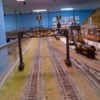Although I have not specifically looked at this signal head, but based on my modifying other MTH signals to work with Custom/Atlas boards, you will have to rewire the heads for common cathode ground. The telephone cord very conveniently uses the red/yellow/green for connecting to the respective position aspect.
The basic signal operation as I remember it is, when train enters block, the circuit turns off the 555 timer extinguishing the green and directly lights the red. When train exits block, the red loses its power and extinguishes and the 555 timer re-energizes to start its timeout, keeping the green off and yellow lighted. After time out the yellow goes off and green lights. The yellow and green LEDs with their current limit resistors are wired in series from 5V hot to ground, and the 555 output line essentially shorts out either the green or yellow LED leaving the other lighted.
With this PRR signal, your green wire would run the vertical LEDs, the yellow the diagonal and red the horizontal. Since there is a middle always lighted LED, you will need a fifth wire to a 5V source to keep it lit (have to use a 6 wire flat telephone wire for white wire).
What all this means is you will have to trace out the board and cut and jumper things such all LED cathodes are grounded and the anodes connected to respective wires. Steady hand, small solder pencil and solder wire.
Clear as mud, right? 











